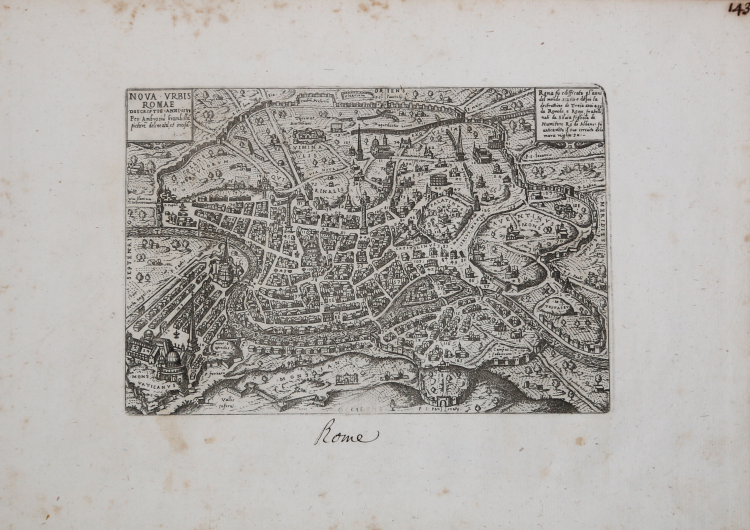



| Reference: | S39442 |
| Author | Ambrogio BRAMBILLA |
| Year: | 1587 |
| Zone: | Rome |
| Printed: | Rome |
| Measures: | 218 x 145 mm |


| Reference: | S39442 |
| Author | Ambrogio BRAMBILLA |
| Year: | 1587 |
| Zone: | Rome |
| Printed: | Rome |
| Measures: | 218 x 145 mm |
A very rare map of the city from the Janiculum Hill, engraved by Ambrogio Brambilla for the publisher Girolamo Franzini. It is a small map, based on the one that Brambilla himself engraved for Claudio Duchetti in 1582, partly updated to the urban reform of Sixtus V. The obelisks of S. Pietro, S. Giovanni and S. M. Maggiore and the via Nova are represented.
The work is of great rarity; Hülsen (1915) describes two examples in the catalogs of the beginning of the century of the Roman antique bookshops Rappaport and Lang. Marigliani (2007) reproduces the exemple of a private Roman collection, with a very large legend, even printed on a separate plate; it is composed of 136 references, of which the first 114 derive from the map of 1582.
Above, in the left box, we find the title and the printing details: NOVA URBIS ROMAE DESCRIPTIO ANNI 1587. For Ambrosiu s brambilla spictore[m] delineatu s et incisa m.
Orientation in the four sides with the name of the cardinal points: SEPTENTRIO, MERIDIES, OCCIDENS, ORIENS, the north is on the left.
Etching and engraving, printed on contempoary laid paper, with wide margins, in perfect condition.
Literature
Bifolco - Ronca, Cartografia e Topografia italiana del XVI secolo (2018), pp. 2406-2407, tav. 1238; Ganado (1994): II, n. 116 e III. n. 93; Hülsen (1915): XVIa, p. 63-64, n. 80; Marigliani (2007): n. 60.
|
Bifolco - Ronca, Cartografia e Topografia italiana del XVI secolo (2018), pp. 2406-2407, tav. 1238.
|
Ambrogio BRAMBILLA attivo a Roma tra il 1579 ed il 1599
|
Italian printmaker and cartographer. He is recorded first in Rome in 1579 as a member of the Congregazione dei Virtuosi al Pantheon, and he remained there at least until 1599, the date of his last work. In 1582 Brambilla produced a series of 135 small engravings of emperors from Julius Caesar to Rudolf II and in 1585 another series, of the popes to Sixtus V. His most successful works, however, were prints of scenographic reconstructions of antiquity such as the Sepulchre of Lucius Septimius (1582) and contemporary views of ancient and modern Rome, for example the Belvedere del Vaticano (1579) and the Fireworks Display at Castel Sant’Angelo (1579). Many of his prints depicting ancient monuments, produced after 1577, were included in the Speculum Romanae magnificentiae. He also produced prints depicting popular games and street scenes. In 1589 he engraved the Last Judgement after a relief sculpture in wax on slate by Giacomo Vivio based on Michelangelo’s painting in the Sistine Chapel, Rome. Two unpublished engravings depict a Perspective Map of Ancona (1585) and a View of the Catafalque for the Funeral of Cardinal Alessandro Farnese (1589; both Milan, Castello Sforzesco). Later sources record Brambilla’s activity as a poet, sculptor in bronze, painter and architect.
|
|
Bifolco - Ronca, Cartografia e Topografia italiana del XVI secolo (2018), pp. 2406-2407, tav. 1238.
|
Ambrogio BRAMBILLA attivo a Roma tra il 1579 ed il 1599
|
Italian printmaker and cartographer. He is recorded first in Rome in 1579 as a member of the Congregazione dei Virtuosi al Pantheon, and he remained there at least until 1599, the date of his last work. In 1582 Brambilla produced a series of 135 small engravings of emperors from Julius Caesar to Rudolf II and in 1585 another series, of the popes to Sixtus V. His most successful works, however, were prints of scenographic reconstructions of antiquity such as the Sepulchre of Lucius Septimius (1582) and contemporary views of ancient and modern Rome, for example the Belvedere del Vaticano (1579) and the Fireworks Display at Castel Sant’Angelo (1579). Many of his prints depicting ancient monuments, produced after 1577, were included in the Speculum Romanae magnificentiae. He also produced prints depicting popular games and street scenes. In 1589 he engraved the Last Judgement after a relief sculpture in wax on slate by Giacomo Vivio based on Michelangelo’s painting in the Sistine Chapel, Rome. Two unpublished engravings depict a Perspective Map of Ancona (1585) and a View of the Catafalque for the Funeral of Cardinal Alessandro Farnese (1589; both Milan, Castello Sforzesco). Later sources record Brambilla’s activity as a poet, sculptor in bronze, painter and architect.
|